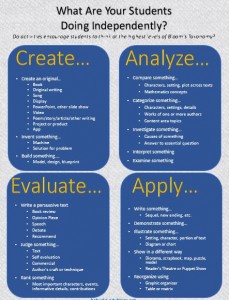 You are convinced to stop using worksheets, but that begs the question: What do I do instead? What kinds of activities can I assign that will keep students on task so I can work with groups and yet require them to think deeply?
You are convinced to stop using worksheets, but that begs the question: What do I do instead? What kinds of activities can I assign that will keep students on task so I can work with groups and yet require them to think deeply?
Using Bloom’s Updated Taxonomy to guide your planning will help to stimulate higher level thinking in your students. Think about it: actually CREATING something–their own version of a book, a machine, an essay or written response–requires a lot more time and effort than simply asking them to remember some information and jot it down on a worksheet.
Requiring students to do activities that are at higher levels has an added benefit: it usually meets a larger number of standards than lower level tasks.
What are some things students can do to show their learning and thinking?
Apply what you read by:
- writing a sequel or new ending.
- illustrating or diagramming
- reorganizing into a chart or table
Analyze what you read by:
- comparing two texts or elements of a text
- categorize something
Evaluate what you read by:
- writing an opinion or persuasive text
- judging something
- ranking something (characters, texts, authors, etc)
Create something based on what you read by:
- writing an original text
- making something related to what you read
- inventing something based on what you read